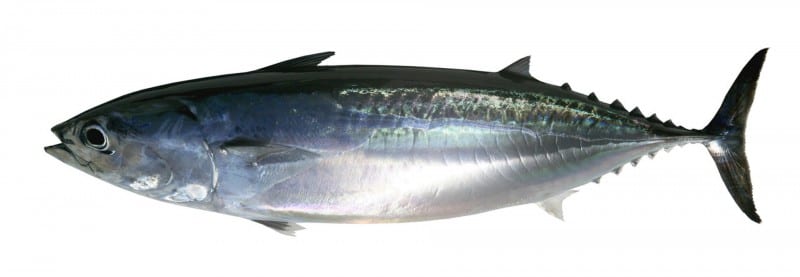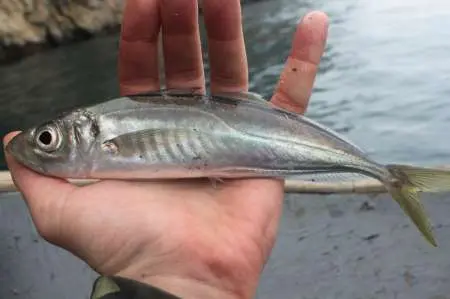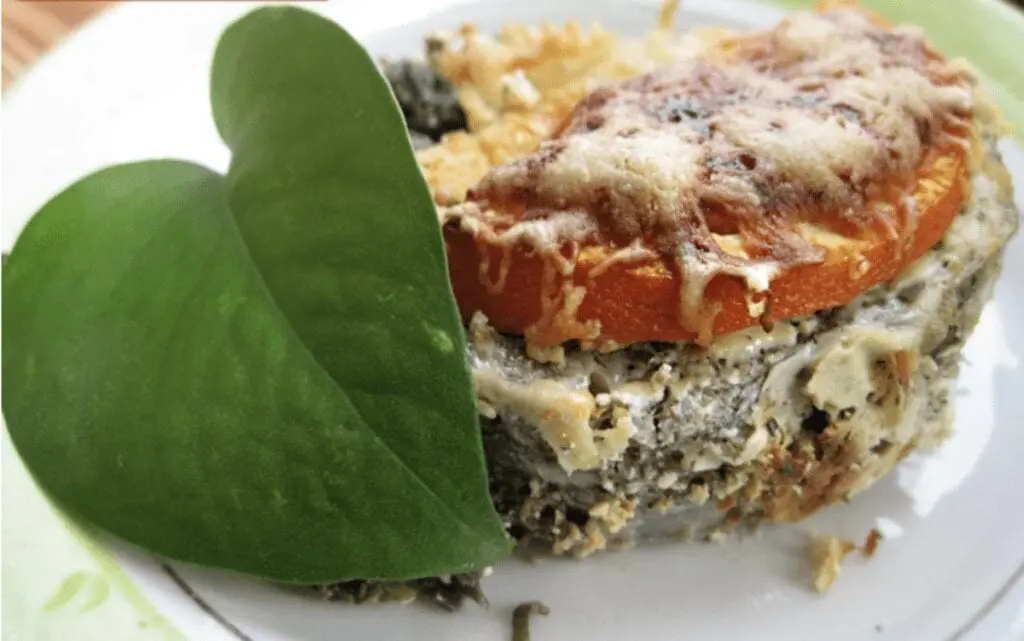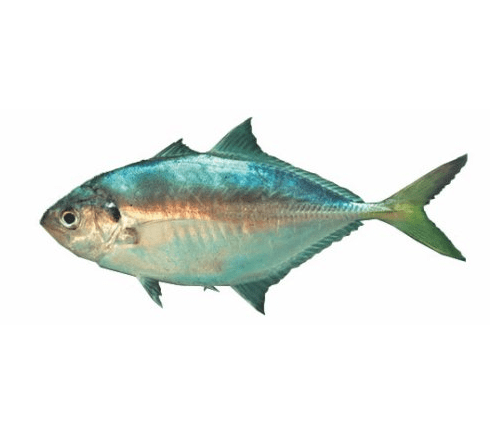Contents
Description
Horse mackerel (Trachurus) – marine schooling predatory fish. The horse mackerel belongs to the ray-finned fish class, the horse mackerel family, the horse mackerel genus. The Latin name Trachurus comes from the Greek trachys, which means rough, and oura, which means tail.
The fish horse mackerel reaches a length of 30-50 centimeters and weighs up to 300-400 grams. True, the weight of some individuals may exceed 1 kg. For instance, the largest individual caught weighed 2 kg. But most often, there are smaller fish.
The body of the fish is spindle-shaped and elongated, covered with small scales. It ends with a thin caudal peduncle and a wide-bifurcated caudal fin. Bone plates with spines are located along the lateral line; some fish’s spines may be directed backward. They protect fish from predators.
Also, horse mackerel has 2 dorsal fins; there are 2 sharp rays on the caudal fin. The average lifespan of this fish reaches about 9 years.
Types of horse mackerel
The genus of horse mackerel includes more than 10 species. The main ones are the following:

- Common horse mackerel (Atlantic) (Trachurus trachurus)
It lives in the Atlantic Ocean and the Mediterranean Sea, in the northwestern part of the Baltic Sea, in the North and Black Seas, in Argentina and South Africa’s coastal waters. It is a schooling fish about 50 cm long, weighing about 1.5 kg. - Mediterranean horse mackerel (Black Sea) (Trachurus mediterraneus)
Lives in the east of the Atlantic Ocean, in the Mediterranean Sea, the Black Sea, the Sea of Marmara, in the southern and southwestern part of the Sea of Azov. The length of this species of this fish reaches 20-60 cm. The lateral line of the fish is completely covered with bony scutes. The coloration of the back is bluish-gray, the belly is silvery-white. The Mediterranean spiece forms localized schools, which include individuals of different sizes. This species consists of 2 subspecies: Mediterranean (Trachurus mediterraneus mediterraneus) and Black sea horse mackerel (Trachurus mediterraneus ponticus). - Southern (Trachurus declivis)
lives in the Atlantic off the coast of Brazil, Uruguay, Argentina, and off the coast of Australia and New Zealand. The body of the fish reaches 60 cm. The head and mouth of the fish are large; the first dorsal fin has 8 spines. The fish lives at depths of up to 300 meters. - Japanese horse mackerel (Trachurus japonicus) inhabits waters of South Japan and Korea and the East China Sea. In the autumn, it is found off the coast of Primorye. The body of the Japanese horse mackerel reaches 35-50 cm in length. Fish inhabits at a depth of 50-275 meters.

Where does horse mackerel live?
The mackerel fish lives in the North, Black, and Mediterranean seas and the Atlantic, Pacific, and Indian oceans. However, several species of this fish are found off the coast of Argentina, Australia, and South Africa. The fish usually swim at a depth of 50 to 300 meters.
When cold weather sets in, common horse mackerel migrates to warmer waters to Australia and Africa’s shores. The coastal waters of Russia are inhabited by six species of the horse mackerel family.
Valuable properties and calorie content

In addition to its wonderful taste, horse mackerel is healthy. Its meat contains up to 20% protein but little fat. If the fish is caught in summer and autumn, up to 15% fat is found in it, and up to 3% in spring. Hence the low-calorie content – in 100 grams of meat, there is only 114 kcal. But at the same time, the meat contains many valuable moral substances – sodium, iron, iodine, calcium, manganese, molybdenum, phosphorus, sulfur, fluorine, cobalt, copper, chromium and zinc, nickel.
In addition to this, there is a large amount of vitamins A, E, folic acid, PP, C, B1, B2, and B6. Such a composition, plus a low-calorie content, make horse mackerel not only tasty but a beneficial food for everyone, even for overweight people. Regular consumption of such fish is a significant contribution to your health.
As for fats, they are represented by unsaturated fatty acids, among which there are especially many Omega-3 and Omega-6, and these acids are extremely important for the functioning of the heart, elasticity of blood vessels, maintaining metabolism and the functioning of the immune system.
- Calorie content 114 kcal
- Proteins 18.5 g
- Fat 4.5 g
- Carbohydrates 0 g
- Dietary fiber 0 g
- Water 76 g
Harm and contraindications
This fish has the unpleasant property of accumulating various mercury compounds in itself. They are extremely dangerous for young children, pregnant and lactating women because these compounds can harm the nervous system’s formation. Horse mackerel is contraindicated for people with individual intolerance to seafood.
Special taste and aroma of horse mackerel

Firstly, the fish from the Stavrid family is prized for their taste. Secondly, medium-fat meat with little or no bones has a delicate texture and is easily separated from the spine. The specific aroma and light acidity clearly manifest during the heat treatment of fish.
Horse mackerel is rich in nutrients and contains a minimum amount of fat (no more than 14 grams before spawning). Therefore, the meat of delicate fish can be included in the diet menu and used for food, subject to the system of proper nutrition.
The use of horse mackerel in cooking
Mackerel with coarse salt, fried in a lot of oil, is a favorite dish of American, Norwegian, and Turkish fishermen. However, almost every country has national specific dishes with horse mackerel:
- In Turkey – with lemon and herbs;
- Greece – with green olives and rosemary;
- In Iceland – with wine vinegar and pickled onions;
- Russia and Ukraine – lightly salted and slightly dried fish;
- In Japan – pickled in rice vinegar with ginger and dry herbs.
Fresh and frozen horse mackerel, due to the absence of bones and fat, is perfect to prepare a variety of dishes:
- Fragrant ear and fish diet soups (traditional and pureed);
- Grilled or oven-baked fish with herbs;
- Fried in corn breading;
- Marinated with tomato or natural vinegar;
- Fish cutlets, meatballs, and soufflés – meat is practically boneless, easily separated from the spine and comfortably chopped;
- Cold / hot smoked fish;
- Canned food with the addition of oil, tomato, or in its own juice for making cold snacks, sandwiches, or as a semi-finished product for soups / main courses.
In conclusion, to fully reveal the taste and aroma of horse mackerel while preserving and keep all the useful substances, you must cook fish at high temperatures with a minimum amount of fat.
Japanese-style horse mackerel

Ingredients
- horse mackerel – 3 pcs.
- lemon – 1/4 fruit
- salt, pepper – to taste
- butter – 3 tablespoons
- sour cream – 1/2 cup
- a bunch of parsley or dill
- orange (or tangerine) – 1 pc.
- grated cheese – 2-3 tbsp.
Recipe:
To cook Japanese horse mackerel you need …
The fish – cut into fillets and sprinkled with juice squeezed from a lemon. Chop the greens and lightly fry with oil. Then add tsalt, pepper, and put the fillets in a saucepan on the fried greens. Pour with sour cream, put orange slices, sprinkle with cheese, and bake in the oven for 15-20 minutes. Serve with boiled rice.
Bon appetite!











Dnncn